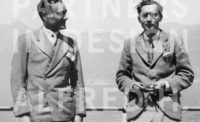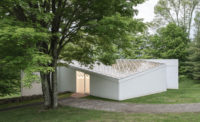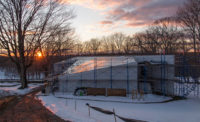Editor’s Note: In June, The Creative Architect: Inside the Great Midcentury Personality Study, by Pierluigi Serraino, will be published by Monacelli Press. The book is based on psychological tests conducted by the University of California, Berkeley, in 1958–59 to try to determine what promotes creativity in architects. RECORD presents excerpts of three case studies of the leading architects of the day—Eero Saarinen, Philip Johnson, and Richard Neutra—along with the author’s summary of the goals, methodology, and findings of this unusual, almost-forgotten investigation. Go back to the main article.
Of the 40 architects in the creativity experiment in 1958–59, Johnson was the most challenging to interview. Often he stood silent for three to four minutes without answering the questions that his interviewer, psychologist George S. Welsh, had posed, therefore compromising the potential of this evaluation. At other times, Johnson’s behavior, ranging from the erratic to the peculiar during the interview, baffled Welsh, who wrote a descriptive two-page summary: “Occasionally he jumped up from his chair and looked at things on the wall or stared out the window . . . The subject seems like a controlled psychotic . . . He showed many classic features of the manic: self-centered, irritable, jumpy, flighty in ideas, arrogant, and using humor to defend himself against serious consideration of anxiety-producing topics.”
Contrary to the persona Johnson created in the public domain and the media, which was characterized by gregariousness, intellectual brilliance, and cultivated vocabulary, he appeared circumspect and stubbornly speechless during much of the interview. The architect was hostile toward Welsh, and started turning questions around to his interviewer. While his intelligence and fluency came across in a few instances—he used a wide and varied vocabulary, was witty, animated, and an interesting conversationalist—he often was ill at ease. On the 10 personality traits, Welsh gave him a 3 for Personal Stability and Adjustment and a 4 for Maturity and Responsibility and Sense of Destiny. On the upper end of the rating scale, Johnson, who did not receive an 8 or 9 in any category, received a 7 for Intellectual Competence.
While Welsh acknowledged Johnson’s legendary verve, Johnson came across as roundabout in his speech. He seemed to hold unrealistic standards for himself and others, and was preoccupied with sexual matters, as well as being arrogant and overbearing, failing to see his own deficiencies and limitations. In such a wide spectrum of behaviors, he was perceived as unusually self-confident, feeling able to meet nearly any situation.
If Johnson’s inner life seemed in turmoil, his daily routine was conservative. He slept between eight and nine hours each night, going to bed at 10:30 p.m. and waking up at 7 or 8 a.m. In the morning he would feel refreshed, stating that he would be alert all at once and begin to work immediately. He felt most effective in the mornings, “10 to 11 or so.” Johnson was a nonsmoker and liked to drink and “did not like people.” He claimed that he resented his older sister, who was similar to his mother: “I never liked her and still don’t.” When asked about his earliest memory, he replied, “My father threw a glass of water in my face once.”
At 18 Johnson suffered a severe case of mastoiditis, an illness that had taken the life of his brother when the architect was 1 or 2. His academic performance was honorable—he graduated second in his high school class. His interests were literary, musical, and dramatic, and his love for the arts and ideas followed him throughout his academic meandering.
Philosophy was Johnson’s main interest at Harvard College, but he took time off from his studies—due to a manic-depressive episode. At age 22, he became passionate about architecture and at 24 was named a co-curator of Modern Architecture: International Exhibition along with Henry-Russell Hitchcock, which opened in 1932 at the Museum of Modern Art in New York City. Shortly afterward Johnson became the head of the architecture department. But by age 28 he left for populist and fascistic political journeys—first to Huey Long’s Louisiana, then to Hitler’s Germany. Six years later, he decided to enroll at Harvard’s Graduate School of Design: “The first day in architecture school was the worst in my life. I did not see how I could stand it,” Johnson said. He was in graduate school from 1940 to 1943 and “fought the administration, so the kids were for me. They actually used my book [International Style: Architecture since 1922] as a text.”
A combination of confidence and scorn permeates his statements. Being well off, he built a house for himself in Cambridge in 1942 as a thesis project. After Harvard, he was stationed in the U.S. Army Corp of Engineers near Washington (so the FBI could watch him, he said). In 1946 Johnson returned to the Museum of Modern Art as head of the architecture department, and started his own firm in 1949, without any prior professional experience in other offices. Johnson considered his unusual talents to be design and selling. When asked what he considered to be the most important things for professional advancement in architecture, he responded, “It’s all luck,” then continued, “A glass house in Connecticut is the reason for my success.” On the subject of creativity, he was blasé: “It doesn’t help to work too hard . . . You can’t get through the thought process. Sometimes you drop your ideas and then you pull one out.” And when it came to his largesse, he just as casually replied, “I give most of my money to museums, and I give scholarships from time to time—$500,000 or so. But I am really stingy.”
In describing his personality through a checklist of adjectives, Johnson—maybe as an expression of self-deprecation—claimed to consider himself autocratic, bitter, boastful, bossy, complaining, cowardly, cruel, deceitful, immature, intolerant, irresponsible, moody, opportunistic, prejudiced, sarcastic, tactless, and unfriendly. None of these adjectives did he provide to describe the ideal architect. On the contrary, he saw that unique individual as assertive and fair, entrepreneurial and emphatic, displaying the type of consistent thoughtfulness he saw himself lacking in. Despite this rather unflattering self-portrait, Johnson’s lifelong commitment to architecture as an art form is evident in his interview responses and his performance at the IPAR study.
Just as legendary was Johnson’s financial wealth, inherited from his father, a lawyer in Cleveland, Ohio. Affluence was at the forefront of his childhood memories: “We were ‘rich kids,’ ” he told the psychologist. His father, “prosperous, gregarious, and jovial,” spoiled him. He grew up in various large houses, and moved from one resort to another both in the United States and Europe. Because of these ongoing travels, he often played alone and read a great deal, although he failed to mention any titles when asked. Characteristic of Johnson’s way of packing contradictions and broadcasting them, he identified with his mother, who “did not like us kids.”







Post a comment to this article
Report Abusive Comment